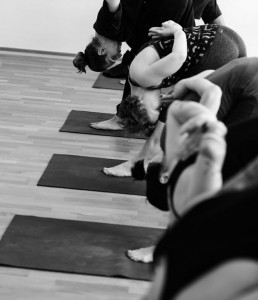
Worth Knowing
Yoga is a philosophy of life, which also has the potential to create a vibrantly healthy body and mind. Ashtanga Yoga, practiced in its correct sequential order, gradually leads the practitioner to rediscovering his or her fullest potential on all levels of human consciousness—physical, psychological, and spiritual.
Through this practice of correct breathing, postures (asanas), bandhas (internal locks) and gazing point (drishtis), we gain control of the senses and a deep awareness of our selves. By maintaining this discipline with regularity and devotion, one acquires steadiness of body and mind.
There are three groups of sequences in the Ashtanga system. The Primary Series (Yoga Chikitsa) detoxifies and aligns the body. The Intermediate Series (Nadi Shodhana) purifies the nervous system by opening and clearing the energy channels. The Advanced Series A, B, C, and D (Sthira Bhaga) integrate the strength and grace of the practice, requiring higher levels of flexibility and humility. Each level is to be fully developed before proceeding to the next, and the sequential order of asanas is to be meticulously followed. Each posture is a preparation for the next, developing the strength and balance required to move further.
Vinyasa means breath-synchronized movement.
The breath is the heart of this discipline and links asana to asana in a precise order. By synchronizing movement with breathing and practicing Mula and Uddiyana Bandha (locks), an intense internal heat is produced. This heat purifies muscles and organs, expelling unwanted toxins as well as releasing beneficial hormones and minerals, which can nourish the body when the sweat is massaged back into the skin. The breath regulates the vinyasa and ensures efficient circulation of blood. The result is a light, strong body.
Breath: The continuity of deep, even breathing cannot be overemphasized in the Ashtanga Yoga system. When breath feeds action, and action feeds posture, each movement becomes gentle, precise, and perfectly steady. According to the teachings of Sri T. Krishnamacharya and Sri K. Pattabhi Jois, —Breath is Life. “Breathing is our most fundamental and vital act and holds a divine essence: exhalation a movement towards God, and inhalation an inspiration from God. Our last action in life is to exhale, which, in essence, is the final and total surrender to God.”
Practice: It is said that where there is no effort there is no benefit. Strength, stamina and sweat are unique aspects of this traditional Yoga, seemingly contrary to Western perceptions of Yoga. This demanding practice requires considerable effort and taps into and circulates a vital energy throughout the body, strengthening and purifying the nervous system. The mind then becomes lucid, clear and precise; and according to Sri K. Pattabhi Jois, —Wherever you look you will see God.Ï Only through practice will we realize the truth of what our guru Shri K. Pattabhi Jois often says: “Practice and all is coming!”
Bandhas: There are three classic bandhas; mula, uddiyana, and jalandhara bandha. They are practiced together or individually at specific times during asana, pranayama, and meditation practice.
Mula Bandha and Uddiyana Bandha are the two bandhas performed during the practice of Ashtanga Yoga. Jalandhara bandha — throat lockÏ is performed consciously during Pranayama. In Pranayama we use all three bandhas together to concentrate the energy inwards. Tribandha (Trayabandha)
Mula Bandha: Root Lock
Mula Bandha provides core strength by supporting and stabilising the spine and moving the energy into the Muladhara Chakra. Developing core strength is an essential part of the foundation of yoga practice and, as such it is important to give time to this before moving on to more challenging asanas. Muladhara Chakra stands for the element Earth. Mula Bandha connects you with the earth energy, giving you firmness and stability.
Uddiyana Bandha: Uddiyana means literally —flying upward.
It is the bandha that moves the energy upward and draws Prana (life energy) out of it’s foundation, the Muladhara Chakra, up through the spinal column. Combined with Mula Bandha, Uddiyana Bandha is responsible for the lightness of movement in Ashtanga Yoga. Uddiyana Bandha connects you with the element air, gives lightness and is helping you to overcome the force of gravity.
Drishtis: Drishtis are gazing points. A focusing technique for bringing more concentration and awareness to your yoga practice. The eyes are always open and inward gazing, they are soft and relaxed. You don‘t look at anyone else. You only look at your gazing point and at yourself. The proper use of drishtis can help means for developing concentrated intention.
Nasagrai Drishti – tip of the nose
Broomadya Drishti / Ajna Chakra Drishti – third eye
Nabi Chakra Drishti – navel
Angusta Ma Dya Drishti – thumb
Hastagrai Drishti – hand
Padahayoragrai Drishti – big toe
Parsva Drishti – far to the right / to the left
Urdhva Drishti / Antara Drishti – up to the sky
ASHTANGA literally means eight limbs.
They are described by Patanjali as: Yama (abstinences), Niyama (observances), Asana (postures), Pranayama (breath control), Pratyahara (sense withdrawal), Dharana (concentration), Dhyana (meditation), and Samadhi (contemplation). These branches support each other. Asana practice must be established for proper practice of pranayama and is a key to the development of the yamas and niyamas. Once these four externally oriented limbs are firmly rooted, the last four internally oriented limbs will spontaneously evolve over time.
“99% Practice – 1% Theory” Sri K. Pattabhi Jois
